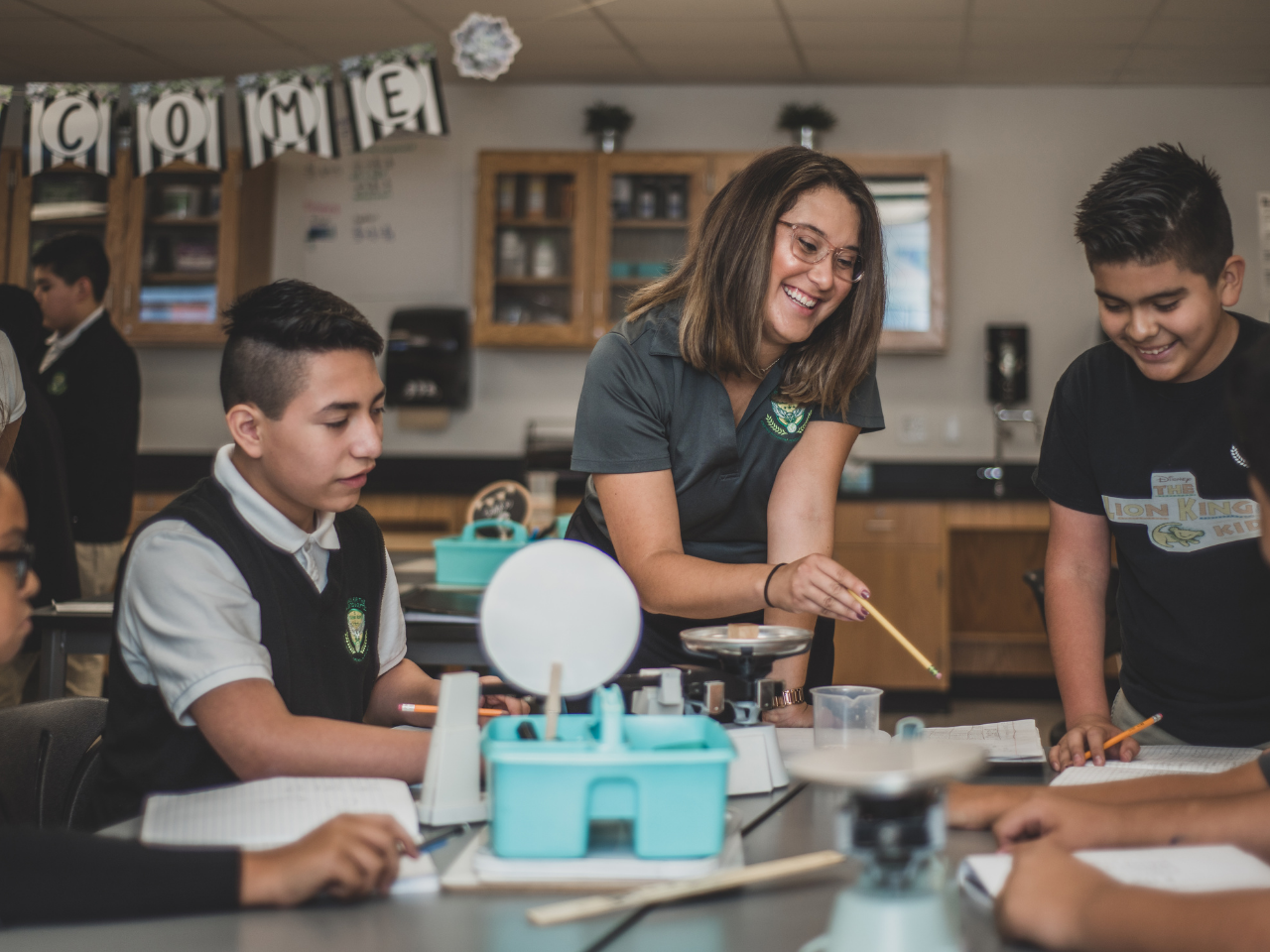How one Texas district built a "College For All" model that's changing lives




This story is part of an ongoing series examining innovative approaches to college and career readiness in North Texas. Garland ISD's partnership with Dallas College demonstrates how aligned vision, courageous leadership, and strategic use of policy incentives can create pathways to economic mobility at unprecedented scale.
When Susanna Russell walked into her superintendent's office in 2019 with what she called a "crazy idea," she had a simple question: "Which kids do we tell no to?"
At the time, Garland ISD had one collegiate academy, one early college program across seven high schools—and a waiting list of more than 300 students. The district had been asked to add one more early college at South Garland High School. But Russell, then leading the district's college and career readiness efforts, saw a different path forward.
"What would it look like if we had a seat for every kid who wanted it?" she asked Superintendent Dr. Rick Lopez.
His response: "Bring me a plan."
Five years later, that plan has produced results that place Garland ISD at the forefront of a national movement. In 2025, students from Garland ISD earned 721 college credentials from Dallas College while still in high school - including 469 associate degrees, 142 level 1 certificates, and 110 career skills achievement awards. That means roughly 15% of GISD graduates earned an associate's degree alongside their high school diploma, a percentage that ranks among the highest in Texas and likely the nation for large urban school districts.
"We're proud of the impact of our early college programs at all seven high schools, where students can earn a high school diploma and an associate degree," says Dr. Jason Adams, Garland ISD's Chief Academic Officer. "These opportunities not only give students a strong start toward college and future success but also offer significant cost savings for families."
The savings are substantial. During the 2024-2025 school year alone, Garland ISD students earned more than 59,000 college credit hours. With Dallas College providing tuition scholarships and the district covering textbook costs of approximately $1.3 million, GISD families saved nearly $3.9 million in college expenses.
Building the Impossible
The vision was audacious: embed both an Early College high school program and a P-TECH program at every one of Garland's seven comprehensive high schools. Fourteen programs total. No waitlists. No telling students they had to choose between college coursework and staying at their home school with their band, their sports team, their community.
Dr. Lopez championed what the district now calls the "College for All" vision, with the goal of expanding opportunities at all high school campuses and the Garland Regional Career, Technology & Innovation Center so that every GISD student has the option to earn college credit while in high school.
But turning that vision into reality required creative problem-solving and unprecedented collaboration.
Dallas College (then the Dallas County Community College District) faced a significant capacity challenge. With multiple campuses and multiple presidents, providing enough college instructors for 14 programs simultaneously seemed nearly impossible.
The solution came through partnership. Garland ISD proposed credentialing its own teachers to teach college-level courses, building a sustainable model that wouldn't overwhelm Dallas College's faculty capacity. The team worked systematically to address each concern and find workable solutions.
The Texas Education Agency was skeptical. No one had attempted something at this scale before. This was before House Bill 3, before the College, Career, and Military Readiness (CCMR) framework that now drives so much of Texas education policy.
The work was painstaking: building blueprints for each program, designing blueprints for each school, finding industry partners for P-TECH programs, navigating approval processes. The effort required coordination across every district department. District leaders worked with TEA on attendance requirements for early college students. Instructional teams developed new supports for participating students.
In February 2020, the district received word from TEA: all 14 programs had been approved. The transformation of Garland ISD's college access model could begin.
The journey wasn't without challenges. Building something at this scale required sustained commitment and a willingness to redesign systems—from master schedules to teacher credentialing to student support structures. But the district remained focused on the core belief that every student deserves access to opportunity.
What Made It Work
The success came from multiple factors working in concert. Leadership from Dr. Lopez and the district's executive team provided the vision and permission to pursue something unprecedented. Several board members had been pushing relentlessly for more dual credit opportunities, and when the bold plan arrived, they provided unwavering support.
"The work has been cross-departmental, and the success is owned and celebrated by all in GISD," Adams notes, “From principals building master schedules to teachers getting credentialed to Dallas College partners who helped realize the vision, the work demanded many hands working in concert.”
Dallas College adapted its entire system to support thousands of Garland students. The college built a model grounded in years of dual credit experience, intentionally aligning systems to meet the scale and complexity of serving students across all seven Garland high schools. Through dedicated dual credit success coaches, students receive personalized guidance from enrollment through graduation. Additionally, free academic resources such as tutoring, writing support, and technology access ensure that students are equipped to thrive in college-level coursework while still in high school.
"What makes the Garland ISD partnership stand out is the intentional investment—both from Dallas College and Garland ISD—in resources, communication, and structures that ensure every student has what they need to succeed," says Dr. Tiffany Kirksey, Vice Provost of Educational Partnerships at Dallas College. "The partnership's student-centered approach, proactive engagement, and mutual accountability have created a model where both institutions truly operate as one team focused on educational excellence and equity."
A foundational element enabling this scale of expansion was the Dallas College Board of Trustees' decision to waive all tuition costs for dual credit students county-wide. This investment removed financial barriers across Dallas County and made it possible for districts like Garland ISD to aggressively expand access—a policy choice that fundamentally reshaped what was possible for college access in the region.
The commitment was fundamentally long-term. The programs were approved in 2020, and the class of 2026 will be the first full cohort to complete the journey from 9th grade through graduation.
The district also built a culture around the vision, creating a "College For All" campaign that distributed messaging throughout the community and built college-going expectations all the way down to elementary school.
The numbers tell the story of that cultural transformation. In the 2020-21 school year, 3,580 students participated in dual credit programming, earning 130 college credentials. By 2024-25, that number had grown to 5,348 students earning 721 credentials—a more than five-fold increase in just five years.
The Policy Power Behind the Programs
The timing of Garland's innovation positioned the district to benefit from Texas's bold new education policies, and the financial impact is substantial. A 10% improvement in college readiness from 2024 to 2025 represents approximately 400 students, potentially unlocking $2 million in House Bill 3 funding. The 721 college credentials earned in 2025 triggered combined HB3 and HB8 funding totaling approximately $8.1 million—resources that flow back to support and sustain the work.
But for Dallas College, the commitment to access came first. "Dallas College's commitment to access and student success long predates HB8," Kirksey explains. "For years, the college has offered free tuition for dual credit students, removing financial barriers that limit opportunity. While HB8 has encouraged a sharper focus on outcomes, it has not fundamentally changed our mission or belief that education should be accessible to every student. We view outcomes-based HB8 funding as an opportunity to strengthen, not redefine, our dedication to equitable access and economic mobility."
Looking ahead, an additional 243 students are on track to earn 9-12 credits this year. Moving them to the 15-credit threshold would triple their three-year degree completion rates at Dallas College and unlock another $890,000 in HB8 funding. These aren't just numbers. They represent sustainable funding for a model that's changing lives.
Why This Matters Now
The impact extends far beyond Garland's borders in several crucial ways. For students and families, those earning associate's degrees in high school save $20,000 to $40,000 in tuition costs. They earn $8,000 to $10,000 more annually than high school graduates—nearly $400,000 more over a lifetime. They're 30% more likely to complete a bachelor's degree because they already know they can do college-level work.
"Students gain valuable experience, confidence, and credentials which make them more competitive in the workforce," Adams explains. Many parents whose children participate in these programs never finished high school themselves, much less enrolled in college, making the pride and sense of possibility even more profound.
For vulnerable populations, the programs offer a critical lifeline. Following a June 2025 court ruling affecting students who cannot demonstrate lawful residency in Texas, early college and P-TECH programs provide a pathway that remains open. These students now face out-of-state tuition rates at Texas colleges—up to $300 per credit hour instead of much lower in-state rates. But education earned while in high school can't be taken away, regardless of immigration status or future location.
For other districts, Garland proves what's possible when vision meets execution. "Garland ISD's success demonstrates what's possible when collaboration, communication, and commitment align around a shared vision for students," Kirksey reflects. "With strong partnerships between K–12 and higher education, large districts across Texas and the nation can replicate this model to expand access, close equity gaps, and transform educational outcomes."
The contrast with nearby districts is stark. While Garland has built comprehensive pathways at every high school, other similar-sized districts have been slower to embrace the model.
The Path Forward
Garland ISD and Dallas College aren't resting on their success. Through a partnership with the Economic Mobility Center—a collaboration between Dallas College and the Commit Partnership - they're developing system advancements that will enhance efficiency, improve data-informed decision-making, and expand shared access to student progress metrics. These forthcoming tools will allow both institutions to better monitor student success indicators and intervene early, strengthening the overall support network for dual credit students.
Adams sees the next frontier as continuing to enhance P-TECH and early college high school programming through sustained collaboration with industry partners and adapting the degrees and pathways offered based on ever-changing workforce needs, both locally and nationally.
Susanna Russell, now President and CEO of Education is Freedom, which provides embedded advisors in districts across North Texas, sees opportunities to strengthen individual advising so every student graduates with a clear plan for what comes next. She also envisions expanded partnerships with employers and workforce boards to connect students directly with internships, apprenticeships, and living-wage jobs in fields like healthcare, IT, and logistics.
A District That Walks the Walk
When asked what this accomplishment says about the kind of district Garland ISD has become, Adams points to the district's mission and vision. "GISD walks the walk, and we live by our mission that GISD 'exists as a diverse community with a shared vision that serves to provide an exceptional education to all its students,'" he says. "College for All programming is one of many examples in programming offered to families that supports our district vision of 'Reaching the future by driving excellence, one student at a time.'"
For district leaders considering similar programs, the work is undeniably challenging. It requires credentialing teachers, rebuilding master schedules, arranging transportation, buying books, managing the complexity of students moving between campuses. Football practice might need to shift a period. The budget impact is real. But the question is whether leaders are willing to do hard things for the right reasons.
Adams reflects on what it means to see 15% of graduates earning associate's degrees while still in high school: "The GISD College for All initiative is life-changing for students and families, and the community, state, and nation all benefit from the work being done in GISD."
Kirksey sees the partnership as proof of concept. "The Garland ISD-Dallas College collaboration proves that when institutions truly work together, they can reshape the dual credit landscape and open doors to opportunity for thousands of students."
The question now isn't whether Garland's model works. The evidence is clear. The question is which other district leaders will have the courage to ask: "Which kids do we tell no to?"






.avif)